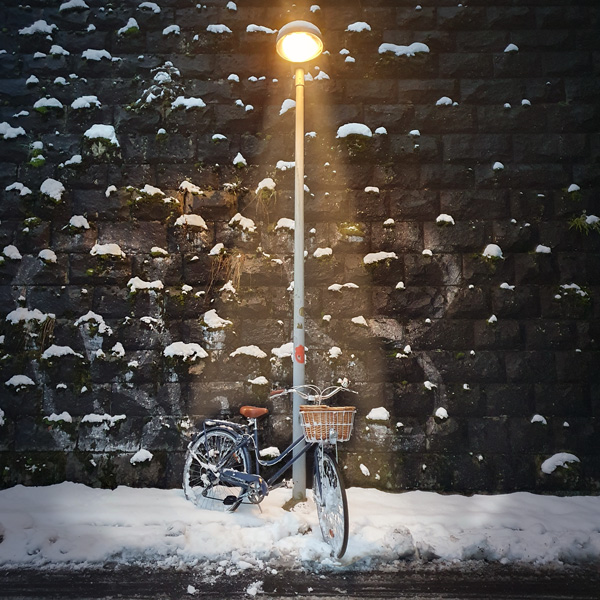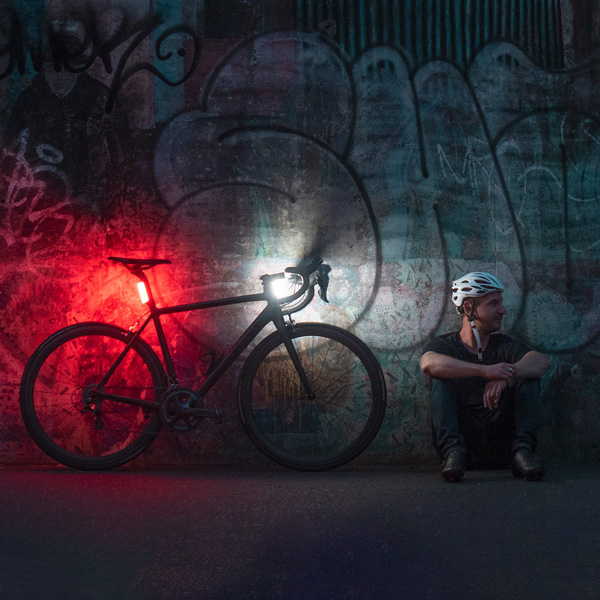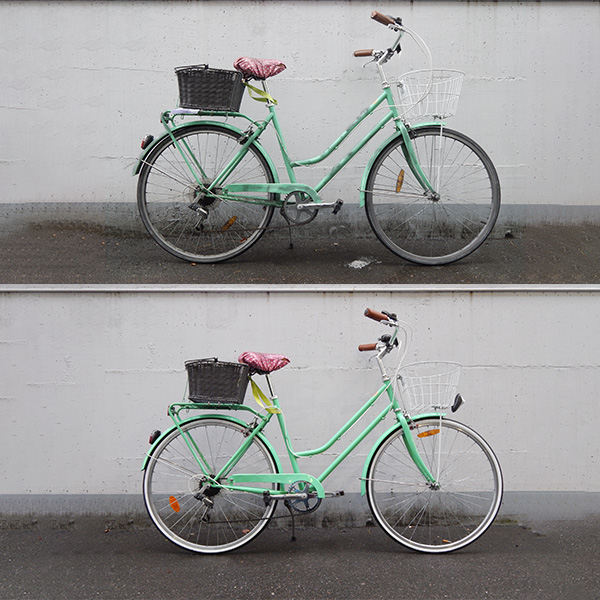On this page we explain in layman's words what to look out for when buying an affordable bike.
Since the turn of the millennium there have been more and more bikes on the market at very low prices. This trend has intensified extremely since electrical wholesalers also wanted to ingest a piece of the bike business cake.
An affordable bike, not a cheap one
Many wonder where is the catch? And in fact, customers always bring cheap goods that they have ordered somewhere on the Internet to us in the store in Münchenstein and are dependent on our help. This must not be understood as automatically affordable = cheap! We at Loris Velos also have inexpensive bikes in our range with our Gangurrus, and there are no problems whatsoever.
Of course, there is always a reason why the 400 francs bike costs less than 3000 francs one. For many, the 3000 francs bike would be just as unsuitable a purchase as the other way around. It is crucial that you understand what you need and cover these needs with your bike.
1. Your Bike Profile
Before we talk about the bike, we need to briefly talk about you. What are your expectations? Do you like to ride speedy or more comfortably? Are you willing to take care of your bike yourself on a regular basis? Do you have a bike room or is does it remain outside in the rain?
Important: You have to understand that when buying a bike there is often no right or wrong, better or worse - but often simply "different". E.g. If you are really braked by the friction on the road with the wide tires of a mountain bike - but you would be completely lost with a narrow new racing bike on the rocky path.
So that you can form a neutral opinion on the following points, you should briefly think about the answers to the above questions. You should primarily consider what the main use of your bike will be in "everyday" use.
Be honest with yourself, especially with regard to your willingness to take care of your bike so that you can both stay happy in the long term!

2. The Bike-Type

The type of bike can usually be identified in the category to which the bike is assigned. Examples are mountain bikes, racing bikes or Dutch style bikes. Each type of bike has its own sitting posture, ranging from straight (Dutch bike, picture) to inclined (MTB) to almost flat (racing bike).
The posture has a substantial effect on the riding experience, because with a different seating position you use different muscles when pedaling. With the Dutch style bike you have a super comfortable, straight posture that is ideal for short distances (5-15 minutes per way), but you work almost exclusively from your thighs and you are fully in the headwind. The trunk muscles assist with the racing bike, which unlocks additional power, but the flat posture is simply uncomfortable for many.
If you like to ride comfortably you will like an upright posture, if you are quickly frustrated because you are not moving forward quick enough you should look for something sporty.
3. Technology
A bike is a mechanical vehicle, and accordingly you could fill entire books about everything from the diameter of the spokes to the bottom bracket to the headset. A book that would only be interesting for bike shops and the two bike nerds who otherwise have nothing better to do.
In order to decide for or against an affordable bike, a rough understanding of the following three areas is sufficient:
Drive
If you are looking for a fixie (1-speed bike), then you can skip this section.
The drive is the heart of the bike and should be selected carefully. As a general rule you can keep in mind: In the low-cost range, only materials from Shimano & no model with colored pulleys on the rear derailleur (the part that throws the chain around). In hilly Switzerland we strongly advise against 3-speed hubs, and advice at least 7+ gears. As for different options, the following two are standard:
Sprocket Gearing: The best-known type, the one where the chain switches between different gears of the sprocket at the rear when shifting. Can also have several chain wheels at the front (for example for a 3x8 gear shift). A 1x7 option is usually sufficient for the city, we recommend more gears for real slopes.
Strengths: Accustomed, cheap, light, maintenance easy to understand.
Weaknesses: Exposed parts (if the bike falls over), more maintenance, shorter service life.
Hub Gearing: With hub gearing, the gearing mechanism is "hidden" in the center of the rear wheel in the hub. To change gears, you have to stop pedaling for a moment. It has the advantage that you can also switch gear while standing.
Strengths: Very low-maintenance and durable, chain cannot fall out, shifting while standing.
Weaknesses: Expensive, unfamiliar shifting process, dependent on a bike shop in the event of a defect, usually fewer gears.

Brakes
Most of the bikes sold in Switzerland have decent brakes. Decent means that you can also stop on a steep slope.
There are certainly levels to that, and the most important thing here is what you are used to - if you have experienced the performance of XT disc brakes on a professional mountain bike, the stopping distance of a normal rim brake seems forever. In general, hydraulic brakes are stronger than manual ones. In addition, different types of brakes have different properties, we present the four most common ones here:
Rim Brakes: It works in such a way that rubber blocks press on the rim (the metal ring of the wheel) from both sides. It is the most common system, easy to understand and causes few problems. Easy maintenance by changing the blocks, performance depends heavily on the materials used. Sub-categories are V-Brakes (better performance, more tedious maintenance) and Caliper Brakes (less force, easier maintenance). In the budget range, material from Promax or Tektro is often used, these are okay, but Shimano is preferable. Avoid Nonames.
Disc Brakes: Instead of the rim, two blocks are pressed onto a narrow, very stable disc, that is bolted to the wheel. Low maintenance because the blocks last a very long time. As a result, the disc brake can physically apply more force than the rim brake, for greater stopping power. Hydraulic disc brakes in particular are very powerful. Stay away from cheap manual disc brakes from unknown manufacturers, these constantly lead to problems. Acceptable manufacturers for disc brakes: Shimano, SRAM, Avid, Magura, Tektro.
Drum Brakes: The lowest-maintenance braking system, widespread in high-quality vintage bikes, rarely in the affordable price range. Similar to the hub gear, everything is contained completely and thus protected from environmental influences. For maintenance, you press a little grease into the brake and then you are ready for many stops again. Are a little heavier, more expensive and have less braking power than the two more common types, but a great investment due to their longevity.
Coaster Brake: Very widespread in the EU, have never found any traction in Switzerland whatsoever. Instead of using a brake lever on the handlebar, you brake by stepping back on the pedals. It works, but many in Switzerland have an aversion to it because it is unusual - including us. Low maintenance, no wearing parts that have to be changed regularly. Coaster brakes are only available for the rear wheel and are usually combined with a rim brake at the front - so you still have one lever to pull.
Lighting
Many bicycles in the cheaper price segment have no light at all, we are not fans of that. By the way, PSA: Contrary to everyday practice, lights are not allowed to blink!
The Swiss Road Traffic Act stipulates that you have to be equipped with two strong lights attached to your bike (front white, rear red) in the dark. Fixed does not mean screwed on, so detachable lights are allowed. When it comes to light, it is a question of where the electricity comes from.

Hub dynamo: By far the best lighting system for everyday use. No noticeable resistance when driving, never changing batteries, strong light output. We recommend!
Hubcap dynamo: The "old" dynamo system in which the dynamo presses against the tire and thus generates and converts resistance. We strongly advise against this system, as it is not only exhausting, but also a constant source of error.
Fixed battery lights: Mostly of decent luminosity, you can't forget it, second best solution after the hub dynamo. Battery change in winter about once a month.
Removable battery / rechargeable battery light: Depending on the product, we recommend a minimum luminosity of 10 lumens for the city and 80 lumens for dark, unlit streets. In the case of battery lights, there is also a trade off between size and battery capacity: the smaller, the more often you have to charge.
4. Assembly state
In our experience, one of the main criteria is whether a cheap offer can be satisfactory. Unfortunately, this is also a pig fashion from the electronics mail order business that goods are handed over to the customer in an uncontrolled manner from the factory. With bicycles this is simply unacceptable and leads to defects, safety risks and ultimately to premature disposal. Many online retailers recommend assembly by a specialist dealer, you will notice a price distortion here as such a final assembly costs a good CHF100. Often you also need special tools for adjusting bearings or straightening 8's, which very few have lying around at home.
With us, for example, all bicycles are unpacked, adjusted and checked before they are shipped. If a partially assembled shipment is required, we always enclose self-made instructions with pictures so that even the greatest layperson can easily carry out the final assembly at home with two left hands.

5. Maintenance

Every bike needs care, but with cheap bikes you really have to do it. With our budget brand Gangurru, we recommend / order our customers to spend 10 minutes a month on maintaining their bikes. In these 10 minutes you pump the wheels, run a rag over the frame, and apply some chain oil.
The rule of thumb is as follows: the more expensive the material, the more forgiving you are if you don't work. Conversely, inexpensive material, especially chains, will quickly be damaged by inadequate maintenance. Cheap chains, for example, like to apply rust film when it is wet - this can be completely avoided by regular oiling.
In addition, inexpensive bikes should definitely be part of the service once a year (recommended for all bikes) to ensure long-term use. This can multiply the life of the bike!
Conclusion
First you have to be aware of what the bike is really used for and how much you are willing to do maintenance yourself. Once you have decided on this, you need a certain basic understanding of what all of Velochinese means in order to understand which offer meets your requirements.
Ultimately, buying a bike is like doing a math problem with the answer to X: The requirements are known, and the equation can be solved with the right formula. It can be a bit exhausting, many don't like algebra. But the good news is that if you are successful, you only need to make these considerations once every 10+ years.
And in any case, we are always available for you to give you detailed advice.
